
This week, I present you with a chance to match wits with The Shadow. Below you will find a short Shadow mystery. It will take about two minutes to read. The Shadow will solve the case, but you won’t be told exactly how. You are challenged to solve the mystery yourself; all the clews are there. (Yes, I spelled it clews.)
This mini-mystery originally appeared on my old Shadow in Review website. There were a series of 262 of these Two-Minute Shadow Mysteries posted between 2003 and 2008. The one presented here today was one of those.
This mystery is based upon the original 1930s pulp character, The Shadow. He had no supernatural abilities; he was simply a man; a top physical and intellectual specimen. He haunted the dark streets of Manhattan in a black cloak and black slouch hat that rendered him “virtually” invisible, allowing him to blend into the shadows. He was a crime fighter of the highest rank. And it is upon this pulp character that this solve-it-yourself mystery is based.
Solving this type of mini-mystery is somewhat similar to discovering a magician’s secrets. If you aren’t told the secret to a magic trick, you may puzzle over it for days. Yet as soon as you are given the secret, you feel somewhat disappointed by its simplicity. But it’s a deceptive simplicity. The solution to this mystery is much the same. If you read the solution today, you might feel let down by its simplicity. The solution… well, the author’s solution, anyway… will appear next week. So, in the meantime, try to figure it out for yourself. It’s much more satisfying.
Feel free to leave your solution in the comments section below.
At the end of this mystery, you will find some background notes on the story. Be sure to read them to learn how the characters and situations presented in the mystery are part of the original Shadow pulp universe.
You are about to enter the pulp world of the 1930s. Join The Shadow as he dons his black cloak, slouch hat, and gloves, and prepares to battle crime. It’s time for action and mystery. The Shadow knows!
The Grove of Death
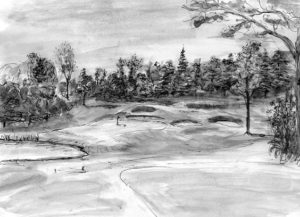
New York Police Commissioner Ralph Weston and his good friend Lamont Cranston were on the golf course of the Beechview Country Club. Beyond a thick grove of copper beech trees, lay the sparkling waters of Long Island Sound.
“Listen!” Commissioner Weston commanded. “A gunshot!”
“It came from inside the grove,” Cranston responded, as they hurried toward the large expanse of tall coppery trees.
As the two neared the treeline, a young man burst from beneath the thickly interleaved branches.
“Which way did he go?” He looked frantically, seeing no one other than the two men heading toward him. “Quick, help me! Uncle Harvey has been shot in the head!”
“Go with him, commissioner,” Cranston rapped. “I’ll circle the grove toward the Sound.”
Commissioner Weston followed the stranger into the dim silence beneath the thick boughs of the beeches.
“I’m Barton Ware. Harvey Chittenden is my uncle. We were taking a cool walk through the grove. I sat down to relax; Uncle Harvey strolled toward the Sound. He wasn’t out of sight for more than five minutes when I heard a gunshot.
“There!” He pointed to a huddled shape on the brownish ground — grassless, yet peculiarly matted.
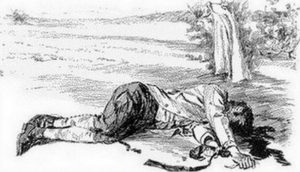
The two men knelt to examine the prone figure. Harvey Chittenden lay with a single bullet wound to the temple. He was dead.
“What happened after you heard the shot?” asked Weston, somberly.
As Barton Ware began to explain, a dark figure moved silently closer through the beech trees. The Shadow was present, listening.
“At first, I was confused; sounds are muffled in the grove. I jumped up and rounded the tree. A man came running from this direction and knocked me down. He appeared to be Oriental. I took up the chase, but when I exited the grove, he was gone. All I saw was you and your friend.”
Weston asked, “Where are you staying?”
“I’m staying at Lower Beechview, the cottage on the far side of the grove.”
“Is there anyone else there?”
“I’m staying there alone. Uncle Harvey has been living at Upper Beechview, on the hill, ever since the murders at Lower Beechview years ago.”
“You have no idea why anyone would wish your uncle’s death?”
“Well…” Ware began slowly, “back then, there was talk of a curse. The name Koon Woon…”
The cloaked figure of The Shadow seemed to materialize beneath the thick-leafed coppery branches. His voice hissed in the ominous silence of the dimly lit grove:
“Koon Woon is no more. This talk of an Oriental assailant is fabrication. The true murderer of Harvey Chittenden stands here, commissioner: Barton Ware!”
WHY DOES THE SHADOW ACCUSE BARTON WARE?
Barton Ware knew his uncle had been shot in the head when he met Cranston and Weston. Yet he later claimed to have chased the murderer immediately, without having seen his uncle. There was no way he could have known the location of the fatal wound, unless… His guilty knowledge points to him as the killer. The Shadow knows!
[/learn_more]Background notes
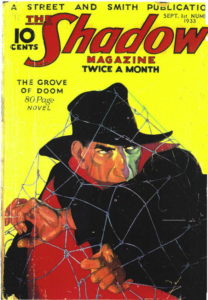
One of the most beloved and famous of The Shadow’s many pulp adventures is “The Grove of Doom,” originally published in 1933. The mini-mystery above takes the reader back to that famous grove of coppery beech trees. The Beechview Country Club, the golf course that tapers down to the acres of sinister beech trees, Lower Beechview on the edge of the Long Island Sound and Upper Beechview on the cliffs to the west. All are back.
In the original story, Harvey Chittenden was threatened by some unknown power that lived in the grove. Koon Woon was the power that killed Harvey’s father and two brothers. It took all The Shadow’s might to defeat Koon Woon. (I won’t spoil the secret of Koon Woon to those of you who have not yet read the story.)
In this story, the sole remaining Chittenden, Harvey, has returned. Here, he meets his demise at the hands of his nephew, Barton Ware, just as his family had succumbed, three years earlier, to the evil machinations of Craig Ware, Barton’s father.
The strange and mysterious Koon Woon had been defeated three years previous to this story — killed beneath the coppery branches of the beech grove. But death now has struck anew in that grove of doom. And once again The Shadow has brought the killer to justice!
The foreboding grove of beech trees will be visited again, in future blog entries. In the future, you can read “The Grove of Mystery,” “The Ghost of Koon Woon,” and “The Haunted Grove.”
Look! Up in the sky! It’s a telephone book! It’s a Sears Roebuck catalog! No, it’s a reference book: The Shadow in Review: The Ultimate Guide to the Pulp Magazine Series. And, if you haven’t ordered yours yet… but, wait. Of course you have. I’m preaching to the choir, here.
But if for some reason you’ve been putting it off, just click here to orders your copy direct from the printer for the low, low cost of only $10 plus shipping. You know you want one. Maybe two…

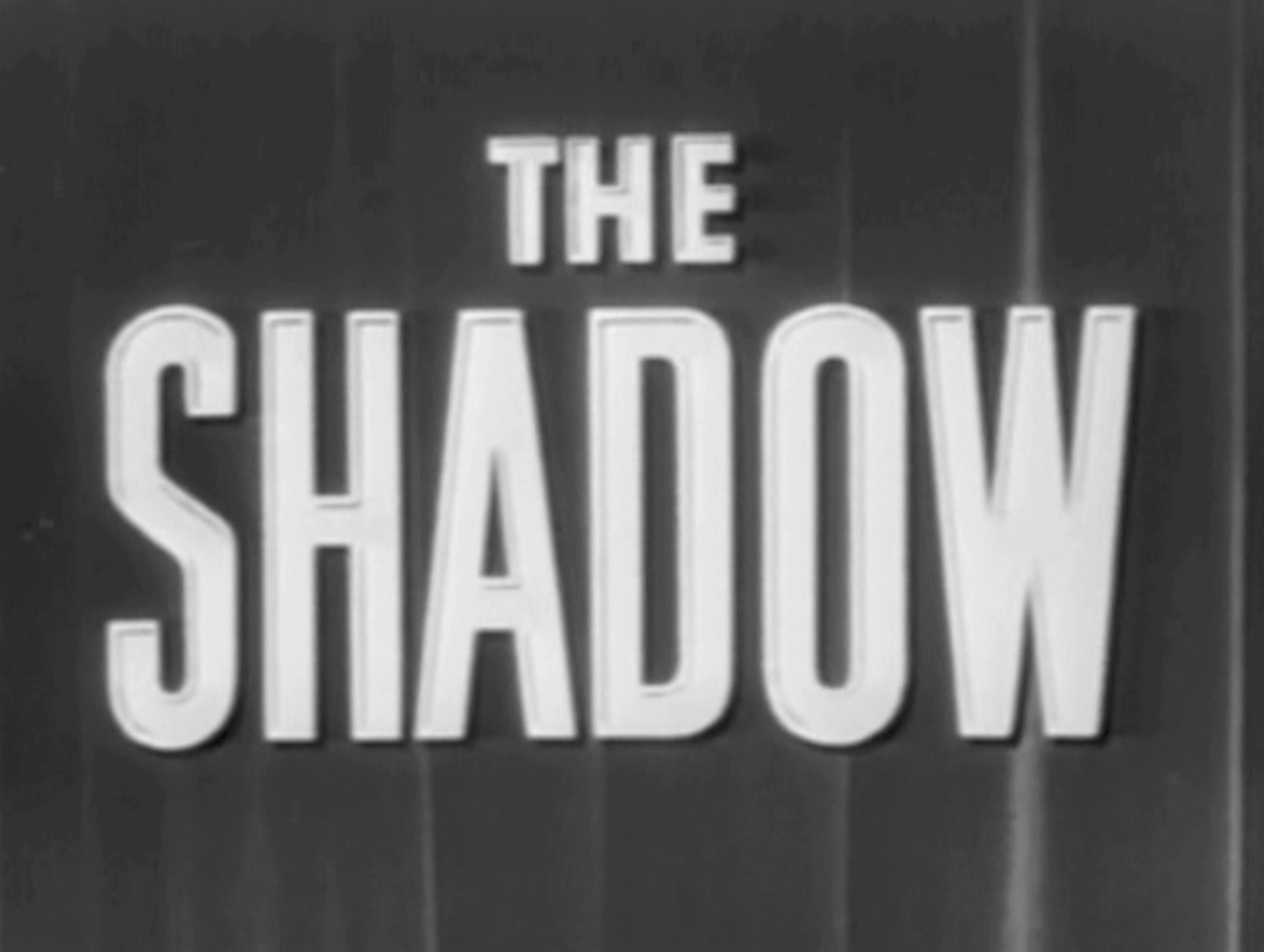
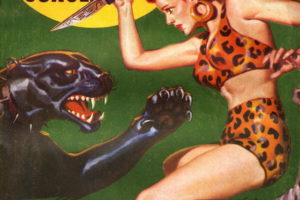
There were no footprints around, or leading to or from the victim, so the Shadow knew Ware lied.
Footprints. Ah, yes, footprints… one of the oldest types of clues. Good old reliable footprints. The story doesn’t exactly address the matter of footprints, whether there were any or not. I wonder if “the brownish ground — grassless, yet peculiarly matted” would hold any footprints.
Seems like if there were any footprints to be found, there should have been some from Harvey Chittenden, at the very least. The killer could have stood at a distance when he fired the shot, or he could have been close by. So his footprints might or might not be found at the scene.
But since the story mentions neither the presence or absence of footprints, I’m thinking that peculiarly matted ground wouldn’t hold footprints. Meaning, the lack of them being mentioned, doesn’t prove Barton Ware a liar. The Shadow, however, believes he lies. Perhaps for some other reason?